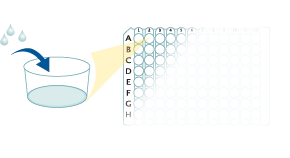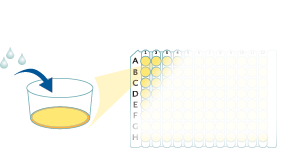Mouse Vitamin D BP Quantikine ELISA Kit Summary
Product Summary
Recovery
The recovery of mouse Vitamin D BP spiked to three levels throughout the range of the assay was evaluated.
| Sample Type | Average % Recovery | Range % |
|---|---|---|
| Cell Culture Media (n=4) | 98 | 94-105 |
Linearity
Scientific Data
Product Datasheets
Preparation and Storage
Background: Vitamin D BP
Vitamin D binding protein (VitD BP), also known as DBP and Gc-globulin, is a 58 kDa glycoprotein that circulates at high concentration in the serum and serves as a carrier protein for vitamin D. The transport of vitamin D by VitD BP is important for the function of a wide variety of tissues. VitD BP binds both the 25(OH) and the hormonally active 1,25(OH)2 forms of vitamin D. VitD BP is primarily expressed in hepatocytes and to a lesser extent in the kidney. It delivers vitamin D into cells by Megalin-mediated endocytosis. A selectively deglycosylated form of VitD BP known as macrophage activating factor (MAF) blocks the angiogenic effects of FGF basic, VEGF, and Angiopoietin 2. VitD BP enhances the chemotaxis of monocytes and neutrophils to the activated complement component C5a or C5a des Arg (a C-terminally processed form of C5a). The chemotactic cofactor property of VitD BP is eliminated by binding to 1,25(OH)2 vitamin D, but it is not altered by binding to 25(OH) vitamin D or actin.
Assay Procedure
Refer to the product- Prepare all reagents, standard dilutions, and samples as directed in the product insert.
- Remove excess microplate strips from the plate frame, return them to the foil pouch containing the desiccant pack, and reseal.
- Add 100 µL of Standard, control, or sample to each well. Cover with a plate sealer, and incubate at room temperature for 1 hour on a horizontal orbital microplate shaker.
- Aspirate each well and wash, repeating the process 3 times for a total of 4 washes.
- Add 100 µL of Conjugate to each well. Cover with a new plate sealer, and incubate at room temperature for 1 hour on the shaker.
- Aspirate and wash 4 times.
- Add 100 µL Substrate Solution to each well. Incubate at room temperature for 30 minutes on the benchtop. PROTECT FROM LIGHT.
- Add 100 µL of Stop Solution to each well. Read at 450 nm within 30 minutes. Set wavelength correction to 540 nm or 570 nm.




FAQs
No product specific FAQs exist for this product, however you may
View all ELISA FAQsReviews for Mouse Vitamin D BP Quantikine ELISA Kit
There are currently no reviews for this product. Be the first to review Mouse Vitamin D BP Quantikine ELISA Kit and earn rewards!
Have you used Mouse Vitamin D BP Quantikine ELISA Kit?
Submit a review and receive an Amazon gift card.
$25/€18/£15/$25CAN/¥75 Yuan/¥2500 Yen for a review with an image
$10/€7/£6/$10 CAD/¥70 Yuan/¥1110 Yen for a review without an image




